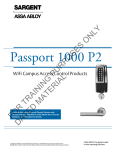Download Kwikset REKYG KIT CP SMT KW Installation Guide
Transcript
Instructions for Removing and Replacing Cylinder of Entry Knob. A. ALIGN SPINDLE B. REMOVE SPINDLE 4 2 1 2 6 3 5 3. Insert cylinder removing tool (2) edgewise between screw stem (5) and 1. Remove key from Cylinder. boss (3) with slot (4). the detent slide (6) rotating tool clockwise to position shown. Apply slight leverage to remove spring tension while holding spindle downwards allowing spindle to drop out. If necessary use free thumb to assist removal. If spindle rotates, repeat step 2. C. REMOVE CYLINDER D. REPLACE SPINDLE 2. Rotate Round Spindle (1) with cylinder removing tool (2) to line up 4 3 7 4. Insert cylinder removing tool in lock housing (7) pushing together 5. Replace round spindle by lining up boss (3) with slot (4) and push E. REPLACE CYLINDER F. HOW TO DETERMINE HAND OF DOOR cylinder retaining springs by moving tool up and down and push cylinder out of knob. If door not available, note position of cylinder in knob for reassembly. PIN COVER UP KEY CUTS UP spindle until the detent spring snaps into place. For Inswinging Door Inside Left Hand Right Hand Outside RETAINING SPRING For Outswinging Door Left Hand 6. Install knob on door if door is available. Inside Right Hand Outside 7. Position cylinder so that pin cover and key cuts are in the upward position (as shown in illustration). Align cylinder with guides in knob and insert, pressing until retaining springs snap into position. 8. If key will not remove, begin again at step “A” and insure step ”E” procedures are followed. The hand of a door is always determined by facing the outside of a door. If the hinge is on the left side of the door, then the door is left-handed. If the hinge is on the right side of the door, then the door is right-handed. WARNING: This Manufacturer advises that no lock can provide complete security by itself. This lock may be defeated by forcible or technical means, or evaded by entry elsewhere on the property. No lock can substitute for caution, awareness of your environment, and common sense. Builder’s hardware is available in multiple performance grades to suit the application. In order to enhance security and reduce risk, you should consult a qualified locksmith or other security professional. 01058-06 Instructions for Keying and Masterkeying Cylinders Procedure is the same, regardless of model shown in illustrations. A. REMOVE PLUG CLIP B. REMOVE PLUG C. REMOVE OLD PINS 2 1 Push plug clip (1) off with screwdriver or cylinder removing tool, using a side to side motion. Insert key and turn plug 1/4 turn clockwise. Push plug out of cylinder with plug following tool (2) and leave in cylinder. The plug following tool will keep the top tumbler pins and springs in place. D. KEY MEASUREMENT E. FOR RANDOM KEYING Measure cuts of key or keys as illustrated, and write down key cut combinations. Note: Random keying uses only one key. For multiple keys, skip to step F (Masterkeying). 1 0 3 2 5 4 6 7 Insert key into plug. Drop bottom pins into proper holes with pin numbers that match measured depths. Tops of pins should be flush with outside diameter of plug. Proceed to step G. F. MASTER KEYING Kits 236 and 272 are capable of masterkeying. Master keying is making one lock work with two keys. Take two keys – one will be the master key which will be able to open all the locks. The other will be the random key or the tenant‘s key, which only opens one lock. 1. Read both keys, (see step D) Master Key Random Key Drop pins out of plug. 5 4 4 4 3 1 2 6 2. Circle the smallest number of each cut. 5 4 3 2 2 Random Key 4 4 1 6 4 REASSEMBLY OF CYLINDER AFTER KEYING After proper pins are in place, leave key in plug. Hold plug in 1/4 turn clockwise position, as when it was removed, in step B. Push the plug against plug following tool until the tool is fully out of cylinder and plug is all the way in. 2 4 Master Key G. INSTRUCTIONS FOR Install plug clip (1) downward as shown, then remove key. 4 4 1 2 2 1 1 0 2 4 2 The circled numbers are your bottom pins required. Drop in the bottom pins without the key in the cylinder. EXAMPLE - 44122 3. Take the difference of each cut. Master Key Random Key 5 4 1 4 4 0 3 1 2 2 6 4 2 4 2 TOP PINS MASTER PINS SHEAR LINE The difference (10242) will be the master pins required. Drop in these master pins on top of the bottom pins without the key in the cylinder. A 0 means that a master pin is not put in that hole. 4. Put plug back into the cylinder assembly without key in the plug. BOTTOM PINS Lake Forest, California U.S.A. Copyright © 2010 Black & Decker Corporation 01058-06













